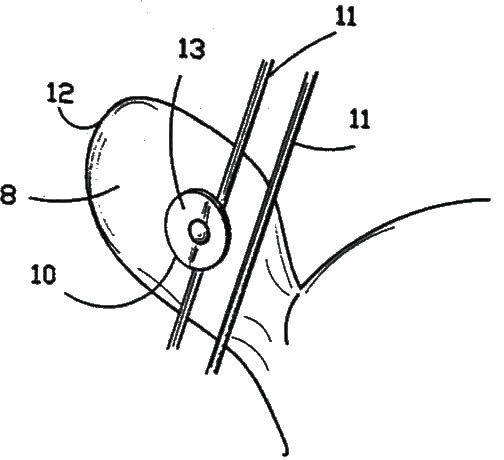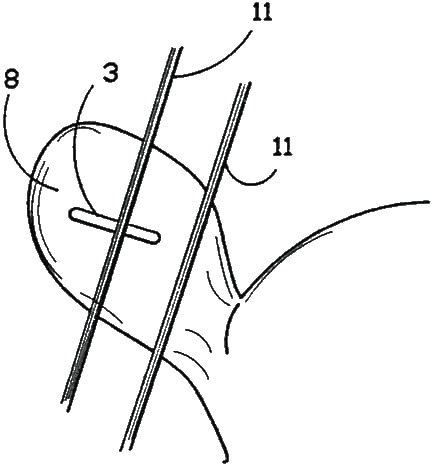About Our Tags
Welcome to About Our Enduro Tags, we have a great product range with great retention, visibility and readability to suit all producer’s requirements.
Our tag innovation is focused on:
Livestock, dairy and wool producer testimonials show how these features work so well for them with our Enduro tags.
So how do our Enduro Tags achieve so much better retention, as verified from our farmer’s testimonials and their comparative conclusions all relate to their previous experiences using single prong tags.
Retention
The design difference --- NO catch points
Our tags are designed to significantly improve retention and have a proven record with over 10 years of production sales and 5 years prior with design, development, field testing and trials.
Single pin and button tags by design have a significant catch point under the flange. That’s way the flange requires flexibility, to fold back when snagged otherwise the ears will be more prone to ripping.
Let me explain further…
Enduro Tags are always placed in the upper, middle gully or hollow of the animal’s ear. ( the gullies are formed in between the ear ridges or veins). This means no matter the type of livestock, whether it's a Brahman, Angus, lamb, ewe goat or pig, the body or strap of the back double pin clip is always positioned lengthways or longitudinal to the ear.
There is no catch-point on the male tag where the stem meets the back-strap of the male clip. Animals always rub their ears in a longitudinal and lengthways direction. So when an animal rubs against objects with our tags, there are no effective catch points. It is much harder for livestock to rub their ears in any other direction as the ear is attached at the ear base to the head, and it's the head movement that dictates the directional movement of the ear.
Male Clip plastic is different to all other cattle tags
We manufacture our male clips with special modified nylon plastic. It is very stable, highly UV resistant and has bacterial inhibitors. Nylon is very stable and inert... in other words, the body doesn’t react to this plastic and is often used in human and veterinary surgery. Our nylon is very hard and tough and so withstands the harsh conditions, the constant knocks and attempts to dislodge.
Single prong two-piece tags are manufactured with TPU ( Thermoplastic Polyurethane). This plastic is much softer and more flexible than nylon. It needs to be this way because there is a lot of overhang on the button male pin. The only way these tags can be released from snagging wire trees feeders is by the flexing and bending the back of the flange or lip on the male pin so as to allow the object to clear the back of the ear.
This technology relies on plastic flexibility to reduce snagging and losses. The more flexible, the less snagging, the more flexible the softer the plastic. The softer the plastic over time, the more these tag types can pull apart.
The double locking mechanism
The harder nylon plastic in our double pin clip insures there are stronger forces required to pull a pin/locking head out of it’s lock. Th nylon material maintains it’s holding strength over the years.
Our stronger pins on the clips require reasonable leverage to break off, and usually if this does happen, its just one locking head. So properties that have say rabbit fencing or previously have high tag losses, you may have a small number tags that have single pin attachment. These tags often stay in the ear for considerable length of time, however single pin attached tags are more likely to be lost over time. It is always the inner pin that is detached, indicating the tag was snagged on the inside of the ear.
Enduro Tag Placement
Placement of any tag is important. Our customer feedback shows that the retention of our tags is greatest when the tag is applied high in the ear and in the top gully. Our Enduro NLIS and management tags are perfect shape for this ear positioning. The back of the ear at this point is flat and the horizontal curve of the ear starts just above this ear gully.
Cattle have difficulty folding back the flat top part of their ear to expose the tag to fencing wire, feeders or scrub obstacles. Placing the tag lower in the ear gives higher exposure to pin breakage as the top fold of the ear gives less protection to the lower ear sections, on the inside of the ear
Customer feedback on our retention
We have producers that have been purchasing our tags and have not lost any tags over a four year period, this is an impressive record. They have placed our tags in the top ear gully. Overall feedback from our customers report that they are very impressed with the retention of our tags. They state our tags perform the best that they have used. The transponders work well and visibility of the tag is an improvement on other tags.
Some losses of our tags that would be about 1% per annum and often seen on properties that have rabbit proof fencing, or access to tree guards with mesh or rubbing on mesh gates. Some producers report no losses at all over many years of use (see our testimonials)
Placing the Enduro Tags in the upper gully just below the ear fold decreases these losses.


You can see in the diagrams above a comparison of a button tag and our double pin clip tag with the back strap being exposed and wire movement away from the ear base, mimicking ring-lock fencing, feeders and scrub. Note there is no catch-point on the double pin clip tag, compared to the overhand of the button tag, where flexibility of the flange is required for release of the tag.
Visibility
Many of our producers state that Enduro Tags are more visible than single prong tags. This easier tag vision saves time and resources in the yards and assists in keeping your data and records accurate.
Why better visibility?
Our tags are designed to be positioned in the middle of the ear. As they don't swivel, they are always in the central ear space, whether viewed from the front or back. Ear hair tends to not obscure our tags, due to central placement and no rotation, especially inwards.
Our “High Tags” are popular with dairy and beef producers as the upright back tag makes viewing from behind the animal more visible, as the tag’s line of vision is above the animal’s shoulder. This is only possibly with the double pin that keeps the high tag upright.
Our tags with wider necks stand out more, and so your livestock are well-differentiated and identified.
Highly polished tools produce a shiny tag surface to keep our tags cleaner
We’ve had several producer’s tell us our tags tend to keep cleaner compared to their previously used tags.
Andrew Kennett in NSW found with his visual stock ID tags that he didn't have to clean them, they kept shining. The lasered serial numbers lasted well and are visible from his working distance. We have spent a lot of time over the years improving our laser marking, we now burn the text and serial numbers deeper, so text is darker and durable.
From customer feedback, we polished the surface our management tag tools in 2018. This has assisted in minimising the amount of dust and dirt the tags accumulate over time and giving better contrast with the laser marking.
Customer follow up indicates that they like the improvements that we’ve made with our print and longer term visual ID.
Transponder readability
Our cattle ET39 and sheep ET45 are electronic tags and are approved NLIS tags licensed through ISC in Australia. Our tags are available for supply as electronic management tags only in other countries that do not prohibit their use.
We also designed the tag/transponder orientation in the ear so as to optimally read for side panel readers. This is the most common panel reader orientation seen with cattle crushes, sheep drafters, dairy cow drafters, weigh scales and on herringbone dairy sheds/parlours. Rotary dairy sheds have small specific panel readers that read close to the animal’s ear.
Our Combo 30 eID tags are used by and favoured by dairy farmers with rotary sheds, because of retention and transponder readability.
Our transponders are made by HID Global, a leader in RFID technology. They are known as glass ferrite transponders as opposed to the coil transponders as used button eID tags.
The glass ferrite transponders have an optimal direction of read. A panel reader can detect a tag up to 1.2m away, if the transponder is facing right angles to the panel reader. So, when cattle are passing by panel readers and if the ear is facing sideways, then the transponder is optimally positioned for the maximum read distance. This means a fast and reliable response.
Button tags, rely on their front face to be opposing the panel reader, for similar optimal distance read distance.
Here at Enduro tags, we’ve designed our NLIS eID cattle and sheep tags to read optimally the majority of the time... as we know reliability and consistency of reads is critical for good data collection.
